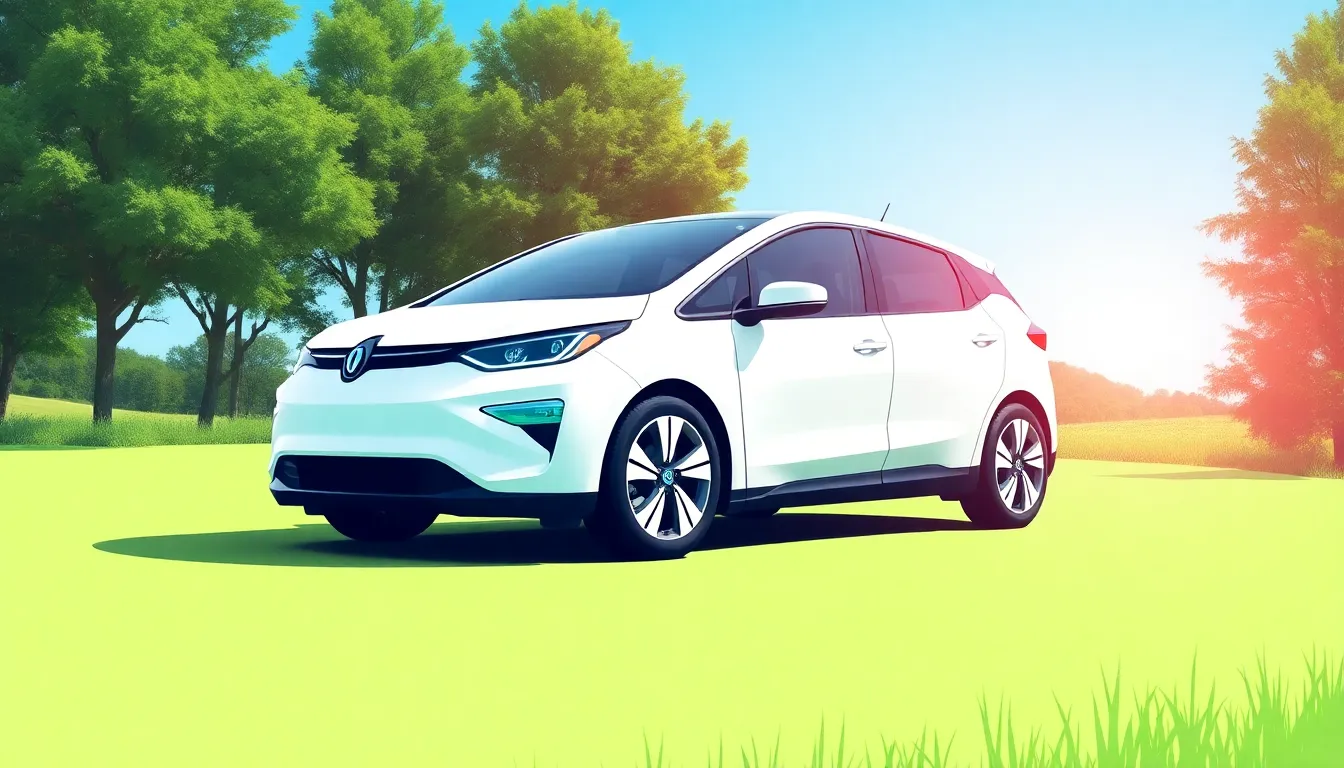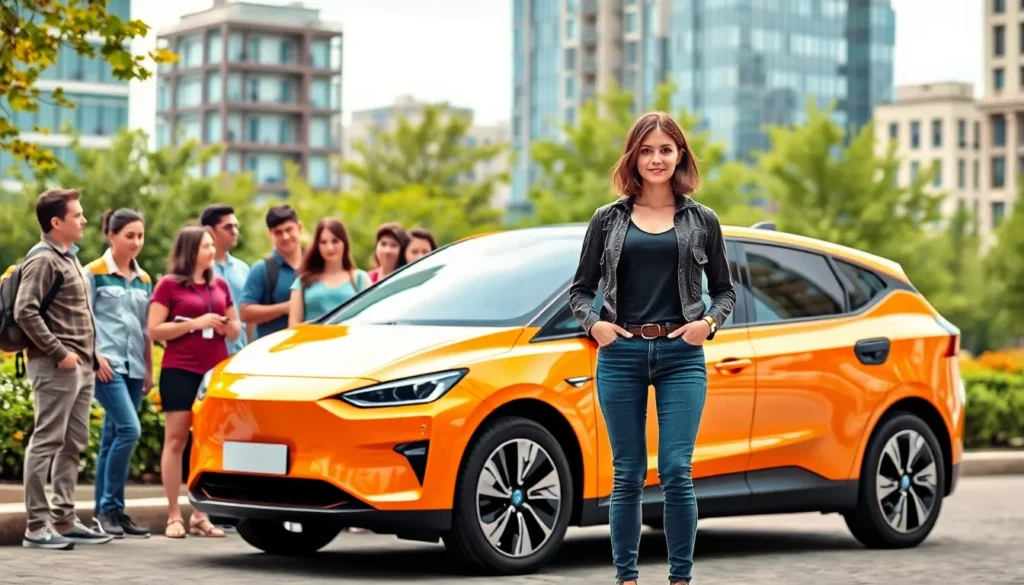In a world where gas prices can make you feel like you’re fueling a rocket ship, electric vehicles (EVs) are zooming into the spotlight. They promise to save you money, reduce your carbon footprint, and maybe even make you the coolest person at the next neighborhood barbecue. But are they really worth the hype, or just another trend like low-rise jeans?
With the rise of eco-consciousness and tech-savvy innovations, the decision to switch to an EV has never been more tantalizing. As they glide silently down the street, many wonder if these futuristic rides are worth the investment or if they’re just a flashy way to show off one’s commitment to saving the planet. Buckle up as we explore the ins and outs of electric vehicles and uncover whether they truly deliver on their promises or if they’re just a smooth-talking salesman in disguise.
Table of Contents
ToggleOverview Of Electric Vehicles
Electric vehicles (EVs) represent a significant shift in the automotive industry, driven by advancements in technology and growing environmental concerns. These vehicles operate primarily on electric power, utilizing batteries that can be recharged. Multiple manufacturers, including Tesla, Nissan, and Chevrolet, have introduced EV models that cater to diverse consumer needs.
Cost savings often attract buyers to electric vehicles. According to the U.S. Department of Energy, the average cost to operate an EV is about $0.04 per mile, compared to approximately $0.11 for gasoline vehicles. This difference translates into substantial savings over time, especially for drivers with longer commutes.
Environmental benefits play a crucial role in the appeal of electric vehicles. Studies indicate that EVs produce significantly fewer greenhouse gas emissions compared to traditional cars, even when accounting for electricity source emissions. Transitioning to electric vehicles can contribute to cleaner air and reduced dependence on fossil fuels.
In terms of performance, electric vehicles often provide quick acceleration and a quieter ride. Many enthusiasts appreciate the instant torque offered by electric motors. Battery technology continues to improve, enhancing range and reducing charging times.
Challenges still exist with electric vehicles. Limited charging infrastructure remains a concern for potential buyers, particularly in rural areas. Battery life and eventual replacement costs can also influence the overall expense of ownership. As technology advances, these issues are likely to diminish, paving the way for broader adoption.
Regulations and incentives further shape the future landscape of EVs. Various governments offer tax credits and rebates to encourage consumers to choose electric vehicles. This financial support, combined with an evolving charging network, can increase the attractiveness of EV ownership.
Benefits Of Electric Vehicles

Electric vehicles (EVs) offer numerous advantages that contribute to their appeal in today’s automotive market. These benefits span environmental, economic, and performance aspects.
Environmental Impact
EVs produce significantly fewer greenhouse gas emissions compared to traditional gasoline vehicles. According to the U.S. Department of Energy, electric vehicles can reduce emissions by up to 70% when charged using renewable sources. Cleaner air results from decreased tailpipe emissions, which benefits public health and reduces respiratory issues. As nations focus on carbon neutrality, EV adoption aligns with global environmental goals. Furthermore, advancements in battery recycling technologies promise to minimize waste generated from defunct batteries, enhancing sustainability.
Cost Savings
Operating an electric vehicle costs approximately $0.04 per mile, while gasoline vehicles average $0.11 per mile. Potential owners can save thousands of dollars on fuel over the lifetime of the EV. Maintenance costs tend to be lower due to fewer moving parts in electric drivetrains. They often incur reduced servicing needs compared to internal combustion engines. Tax credits and government incentives further increase the financial appeal. With rebates available in various states, the upfront cost becomes less daunting for new buyers.
Drawbacks Of Electric Vehicles
Electric vehicles offer multiple advantages, yet certain drawbacks warrant consideration.
Initial Purchase Price
High initial purchase prices remain a significant hurdle for consumers. Many electric vehicle models cost between $30,000 and $80,000, which can deter potential buyers. While federal tax credits and state incentives can mitigate these costs, they don’t eliminate the price gap between traditional gas vehicles and EVs. Affordability often becomes a barrier, especially for budget-conscious consumers. The upfront costs also factor in when considering total ownership expenses over time. If a consumer prioritizes immediate financial outlay, choosing a gas vehicle might seem more appealing.
Charging Infrastructure
Limited charging infrastructure presents another challenge for electric vehicle adoption. Rural areas often lack accessible charging stations, making long-distance travel difficult. Many urban settings provide charging options, yet public stations can become congested, leading to longer wait times. Charging an electric vehicle at home requires a compatible outlet, which may not be available in every residence. If current infrastructure doesn’t improve, consumers may hesitate to fully commit to EV ownership. Addressing these concerns directly impacts the feasibility of integrating electric vehicles into daily life.
Comparisons With Traditional Vehicles
Comparing electric vehicles (EVs) with traditional vehicles reveals significant differences. Fuel efficiency stands out as a major advantage for EVs.
Fuel Efficiency
Electric vehicles offer remarkable fuel efficiency, significantly reducing the cost of energy per mile. Operating an EV costs approximately $0.04 per mile, whereas gasoline vehicles typically incur expenses of around $0.11 per mile. The disparity in operational costs easily accumulates, leading to substantial savings over time. Enhancements in battery technology further improve energy usage, allowing EVs to maximize their driving range with minimal charge. As an example, many recent models include regenerative braking systems, which convert kinetic energy into stored energy, increasing efficiency during city driving.
Maintenance Costs
Maintenance costs for electric vehicles tend to be lower compared to traditional vehicles. EVs feature fewer moving parts, which results in decreased wear and tear on components. This simplicity translates to less frequent servicing and a reduction in repair costs. Brake wear is often less in EVs due to regenerative braking, allowing for longer intervals between replacements. Battery maintenance generally remains straightforward, and the average lifespan extends from 8 to 15 years. While some consumers express concerns about battery replacement expenses, which can range from $5,000 to $15,000, available warranties and advances in recycling technologies help mitigate these worries.
Market Trends And Future Outlook
Electric vehicle (EV) sales steadily increase, reflecting broader trends in consumer preferences and environmental awareness. In 2023, EV sales reached approximately 1.5 million units in the United States, showcasing a growth rate of 60% compared to the previous year. Market forecasts predict that by 2030, EVs could account for over 30% of new car sales, driven by consumer demand for sustainable options and advancements in technology.
Regulations play a critical role in shaping the EV landscape. Many governments worldwide aim for stringent emissions targets, incentivizing the transition to electric mobility. Federal tax credits up to $7,500 encourage consumers to consider EVs, enhancing affordability and stimulating market competition. Additionally, infrastructure investment by both public and private sectors is expanding charging networks, facilitating everyday use of EVs for more consumers.
Battery technology continuously evolves, addressing range anxiety and charging times. Current advances include solid-state batteries, promising longer life spans and quicker charging capabilities. As these technologies improve, expectations suggest EV ranges will soon exceed 400 miles on a single charge.
Consumer attitudes also shift positively. Over 60% of prospective car buyers show openness to purchasing an electric model, highlighting a significant change in perception. Automakers are capitalizing on this shift, with companies like Ford and General Motors investing billions in electric vehicle development.
Challenges persist but show signs of resolution. Charging infrastructure remains a concern, especially in rural areas, but initiatives continue to expand access. Overall, the market signals a promising future for electric vehicles as benefits blend with growing consumer acceptance and improved technology.
Electric vehicles are reshaping the automotive landscape by offering compelling advantages that resonate with eco-conscious consumers and budget-minded drivers alike. The combination of lower operating costs and environmental benefits makes EVs an appealing choice for many. As technology advances and infrastructure improves, the barriers to adoption are gradually diminishing.
While challenges remain, including initial costs and charging accessibility, the momentum behind electric vehicles is undeniable. With growing consumer acceptance and supportive government policies, EVs are likely to play an increasingly significant role in the future of transportation. Ultimately, the decision to invest in an electric vehicle hinges on individual needs and circumstances, but the potential benefits are clear.




